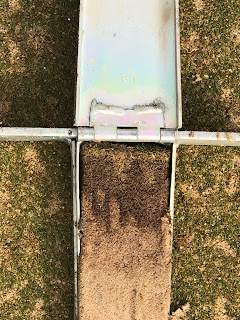Before I spend time on the actual process, I want to thank our club membership and leadership for the 2-day extension. The week prior, we received an inch of rain on Tuesday and several inches of snow on Wednesday. Couple the precipitation with frigid nights that were setting up long frost delays and we could not have accomplished what was accomplished without our club's support and patience. So, on behalf of our maintenance team, Thank You!
Our spring aeration has become the bedrock for our agronomic plans each season. We use this time to disturb a tremendous amount of turf. The timing of our spring aeration works well because the weather is conducive to aggressive practices without collateral injury and golf levels are generally very low so our membership experiences minimal discomfort.
Generally, I walk through each turf area (green, tee, fairway, etc.) and explain what we do and how we do it. This summary will still cover our putting surfaces, but focus more on the level of general topdressing across the property.
Our greens are first topdressed with a sizable layer of USGA spec putting green sand. This season, we were able to apply just over 1200 lbs. of sand for every 1000 square feet of surface. Once the sand is applied, our greens are deep tined with 1/2" diameter tines to a depth of 7". These holes are drilled in on 2" x 2" spacing. These deep tines not only create deep and sustainable channels for advantageous spring rooting, but fracture the soil as they move up and down. Following the deep tine, the greens are aerated with 1/2" diameter coring tines to a depth of 2.5" and a spacing of 2" x 2". Following this aeration, the same machine with the same specs makes a second pass at an alternate angle. Once the cores have dried, they are broomed to the perimeter of the green for removal. Following a second blowing, the greens are swept in three different directions to assure that all of the holes and channels are full with clean fresh sand. After the sweeping, the greens are rolled three separate times and then fertilized and watered. The first morning of re-opening, we mow the greens for the first time and we are off and going!
This is what the finished product looks like. Many holes filled with sand. According to the ISTRC displacement chart, we displace about 15% of our surface area. Considering that the USGA recommends 20% displacement for the whole season, we accomplish 75% of that goal in one aeration.
There is no question that this is an invasive and aggressive aeration. Yet, we are not only passionate about it, but extremely excited about what it does for our turf.
As greens mature, the sandy profile that is full of air porosity, infiltration and percolation begins to "slow down" as naturally occurring organic bio-mass begins to accumulate. Simply put, as the profile matures, the plant's ability to breathe is reduced. The screenshot below, shows some data work we did on our 5th green.
But the maturity of the profile is not all bad. In fact, as the profile matures, its' ability to retain moisture and nutrients increases. Plants need food and water to survive, but they also need oxygen. So the best case scenario is a soil that drains and breathes like sand, but retains nutrients and water like top-soil.
To achieve this mythical balance, cultural processes can bridge the gap. By removing piles, literally, of old stagnate profile and replacing it with clean fresh sand, we can achieve the best of both worlds. We can maintain a profile that breathes, while still retaining nutrients and water.
The profile shot above was taken from our 9th green. In the photo you can see the darker material and the lighter channels streaking about. These lighter channels represent the clean channels that are created through topdressing and aeration. Furthermore, if you look closely at the canopy, you can see the topdressing layer that is responsible for thatch suppression, smoothness and firmness.
Although not as aggressive, our fairways tees and approaches were verti-cut, deep tined and topdressed. This time around, we spread over 2,000,000 pounds of sand. So while it is sandy now, the dividends for the future will be immeasurable.







